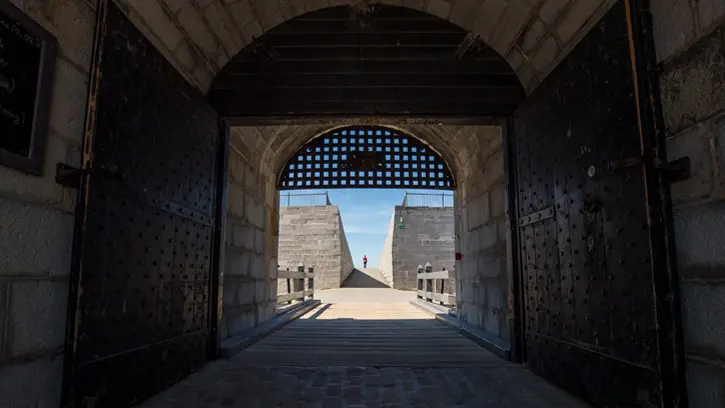Explore historic forts and castles in Ontario

Fort Henry | Destination Ontario
Though home to Indigenous people for thousands of years, the earnest wave of European expansion in North America began in the 15th century, followed by centuries of colonization, claims and conflict by the French and English.
By the 18th century, borders began to form, and Upper Canada—present-day Ontario—was established. Meanwhile, the Napoleonic Wars of the Old World gave rise to tensions between the United States and Great Britain in the New World, and the War of 1812 lasted for two years along the border between the US and Upper and Lower Canada. Much of the military and some naval combat took place in Upper Canada. The Treaty of Ghent was signed in 1814. It signalled the end of the war and, as many historians would agree, laid the foundation for a national Canadian identity.
Several heritage homes, castles, military forts and strongholds in Ontario still stand and have been carefully restored and preserved. Experience guided tours with battle re-enactments, uniforms, weapons, barracks supplies and other artifacts showcased at military fortifications and architecture, furniture and design depicting the style and culture of the day at castles and historic homes.
Ottawa Region
Fairmont Chateau Laurier
Completed in 1912, this landmark Ottawa hotel was constructed by the Grand Trunk Pacific Railway Company and overlooks both the Ottawa River and Rideau Canal.
Lovely grounds and gardens surround the commanding limestone chateau and complement its French Gothic Revival features, such as the ornate gables, dormers, pavilions, towers and turrets.
Location: 1 Rideau Street, Ottawa
Greater Toronto Area
Casa Loma
Another mansion built in the Gothic Revival style embraced in Canada in the early 20th century, this Toronto landmark museum is perhaps the most iconic castle in Ontario.
Spanish for “hill house,” Casa Loma sits high atop Davenport Hill with spectacular views of the city below. It’s a popular tourist spot, so make sure to get there early if you want to shoot the stained-glass windows, the grand fountain at the entrance and upscale furnishings in solitude.
Location: 1 Austin Terrace, Toronto
Fort York National Historic Site
Dwarfed by high-rises and highways, the heritage site of Fort York is nestled in the heart of downtown Toronto.
It was built in 1793 to defend the harbour of the settlement of York, which was to eventually become the city of Toronto. To prevent it from falling into the hands of the Americans, the fort was destroyed in 1813 and rebuilt the following year.
Eight original buildings still stand, including blockhouses and barracks.
Location: 250 Fort York Boulevard, Toronto
Hamilton, Halton and Brant

Battlefield House Museum & Park National Historic Site
Step into history at a site once vital for farmers, preachers and Indigenous peoples to trade and gather. Explore a historic home built in 1789 and a 30-metre-tall (100 feet) battlefield monument honouring a century of peace between Britain and the United States.
On June 7 and 8, 2025, experience a live re-enactment of the 1813 Battle of Stoney Creek and enjoy period games, demonstrations, historical music and food. The event also features Indigenous programming, including a “Great Peace Game” of Haudenosaunee Lacrosse. New this year is a drone light show following the Saturday evening battle.
Location: 77 King Street West, Stoney Creek
Dundurn Castle
The 40-room Italian neoclassical-style villa on York Boulevard in Hamilton took three years to construct, finally ready in 1835 for lawyer and politician Sir Allan Napier MacNab and his family to take residence.
Warm golden columns and pale white walls make the mansion perfect for photographing at the golden hour of dusk as the setting sun illuminates the building. As a bonus, Dundurn Castle has the beautiful backdrop of Burlington Bay to the northeast.
Location: 610 York Boulevard, Hamilton
Southeastern Ontario
Fort Henry National Historic Site
Great wooden gates, strong stone defence walls, the sprawling main square and the award-winning Sunset Ceremonies featuring a drill squad and artillery detachment re-enactments make for an array of engaging photo options at this 19th-century British military post.
The UNESCO World Heritage Site is located just outside of Kingston by the mouth of the Cataraqui River and is easily one of the most impressive forts in the country.
Construction began in 1812, strategically atop a hill called Point Henry for sightlines over the St. Lawrence River and to protect the Kingston Royal Naval Dockyard.
Fort Henry, named after Henry Hamilton, former Lieutenant-Governor of Quebec, was rebuilt in 1830, restored 100 years later and is now one of Ontario’s most popular heritage attractions with tours and special events taking place throughout the year.
Location: 1 Fort Henry Drive, Kingston
Fort Frederick
Just across the river from Point Henry, the battery of Fort Frederick experienced action in 1812, defending from an American naval squadron attack. It was destroyed and rebuilt in 1846 after the Rideau Canal opened, requiring further fortification.
The result was the most robust armament of any fort in Kingston, with 32 carronades built into five-metre-thick walls. Despite the investment in reinforcement, Fort Frederick was abandoned just decades later in 1870. Today, it functions as a park for the Royal Military College cadets.
Location: 15 Passchendale Drive, Unit 9, Kingston
Fort Frontenac
One of the oldest forts in Ontario, Fort Frontenac was erected as a French trading fort in the summer of 1673 at the spot where the Cataraqui River meets the St. Lawrence.
Although today it’s currently in use by the Canadian military, Fort Frontenac changed hands several times over the last few centuries. It was abandoned by the French in the late 1600s before being rebuilt a few years later. The fort was instrumental in the famous Battle of Fort Frontenac when British forces overtook the French trading post during the Seven Years’ War. By the late 1800s, Fort Frontenac became the property of the Canadian military. Tours are by invitation only.
Location: 388 Ontario Street, Kingston
Niagara Region
Old Fort Erie National Historic Site
Witness the dramatic scene of a fortress under siege with cannon fire and redcoats in action at Old Fort Erie, a key defence site during the War of 1812 that was originally constructed in 1764.
From its construction in 1764 to 1812, Fort Erie battled flooding, ice, and stormy weather, not war, until it was captured by the Americans in 1814. They abandoned it that same year, and eventually, the fort was restored in 1939. In 1987, the remains of 28 American soldiers were exhumed and returned to the US with full military honours.
Today, Fort Erie is operated by the Niagara Parks Commission.
Location: 350 Lakeshore Road, Fort Erie
Fort George National Historic Site
If these walls could speak, Fort George would tell quite the tale. Instead, hear the saga of this military outpost from interpreters dressed in redcoats who reenact significant parts of the battle, complete with scheduled musket fire.
The fort was created in 1796 to replace Fort Niagara, a defence hold awarded to the United States in the Treaty of Paris. During the War of 1812, Fort George and Fort Niagara dueled it out with the Americans victorious in 1813, only to be recaptured by the British that same year.
Open seasonally with special events, demonstrations and tours held throughout the summer.
Location: 51 Queen’s Parade, Niagara-on-the-Lake
Huron, Perth, Waterloo and Wellington
Castle Kilbride
Located outside of Stratford, Castle Kilbride is a grand Victorian home.
It was built in1877 in the Italianate style of architecture, complete with a belvedere lookout and decorated to the hilt with Trompe I’oeil (creating optical illusions using imagery and depth) ceiling and wall murals and lavish Victorian era furnishings.
Location: 60 Snyder's Road West, Baden
Northwest Ontario
Fort William Historical Park
Located on the outskirts of Thunder Bay in northern Ontario, Fort William is one of the largest living history sites in Northern Ontario and certainly one of Canada’s most unique heritage attractions.
The park recreates what a Canadian fur trade post would have looked like in 1816, at the height of the North West Company.
Capture the fascinating culture of fur trade life from farm to craft to cuisine with amazing costumed re-enactments and events.
Location: 1350 King Road, Thunder Bay
White Otter Castle
Not many know about the legend of Jimmy McOuat at White Otter Castle, an incredible three-story wooden structure constructed single-handedly on the shores of White Otter Lake in 1914.
Just getting to the site of this remote ‘castle’ is impressive enough before you consider what a feat it was for one man to build. White Otter Castle is accessible by float plane or canoe in the summer and snowmobile in winter.
Location: White Otter Lake
Southwestern Ontario
Fort Malden National Historic Site
Initially named Fort Amherstburg, this was the site of a dizzying back-and-forth volley.
The fort was constructed in 1795. It was burned down by the British in 1813 and rebuilt by occupying American soldiers in 1813, the longest American occupation on Canadian soil. It was restored and renamed in 1819, rebuilt, and maintained by retired soldiers until 1859, when it served as an ‘insane’ asylum and a lumber yard, among other things, before being recognized and preserved as a national historic site in 1921.
A large collection of artifacts can be viewed in the museum. Open seasonally with special events, demonstrations and tours held throughout the summer.
Location: 100 Laird Avenue South, Amherstburg
Sault Ste. Marie and Algoma
Fort St. Joseph
Set on the southernmost spot of St. Joseph Island, facing Lake Huron and St. Mary’s River, this former British fort included a blockhouse, bakery, powder magazine and storehouse after construction began in 1796. At the time it represented the most westerly outpost of the British Empire.
Parks Canada maintains the site, preserving the limestone ruins and their stories of struggle and peace.
Related content
Last updated: May 22, 2025


